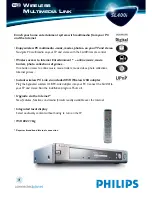
0
DK ENG
2.0 Firing/using the stove
The heat emission of the stove is regulated with the regulation lever under the door.
The stove uses three types of combustion air.
The secondary combustion air is supplied down along the glass. This air is regulated with the
lever under the door.
The tertiary combustion air is supplied to the combustion right over the fire. This air supply
may not be regulated.
The pilot combustion air provides for the activation of embers and keeps the combustion go-
ing even at the lowest damper position. This air supply comes from two nozzles on the front
frame below the door. This air supply may not be regulated.
The nominal heat output of the stove is 6.5 kW.
Your new Morsø stove is EN tested and recommended for burning wood.
nB!
Wood is a material that contains a great deal of gas (approx. 75%). the gases are re-
leased when the wood is lit and heated. For this reason, it is important that these ga-
ses are ignited quickly after stoking. If the wood just lies smouldering, especially after
re-stoking, a lot of smoke is created which, in the worst case, may cause an explosive
ignition of the gases, resulting in damage to the stove.
In order to ignite the gases that are released from the wood, and to keep clear, lasting
flames during the combustion process, it is important to let in the required quantity of
oxygen (air supply) at all times. the setting of the air supply, the method of ignition and
the lighting intervals depend on the draught in the chimney, the wind and weather, the
amount of heat required, the fuel, etc. this means that it may take some time before
you get to know the correct functioning of the stove under any given circumstances.
Although you can fire your Morsø stove with almost all kinds of wood, you should not
fire with wet wood, or unseasoned wood. Wood ought to be stored under a roof for at
least 1 year, and preferably 2 years, with free access to wind. Wood should be chop-
ped as soon as possible after felling if it is to dry quickly. the wood can be used once
the moisture is less than 20%. During the en test, all stoves are tested with wood with
a moisture content of (16 ± 4)%.
never use driftwood as it usually has a high salt content, which damages both the st-
ove and the chimney. Impregnated and painted wood and chipboard emit poisonous
smoke and fumes so they should not be used as fuel either
Please note that liquid fuel may not be used in the stove.
Pieces of wood with a diameter exceeding 10 cm should always be chopped.
the pieces of wood should be short enough to be able to lie flat over the layers of
embers, with air at both ends. the maximum length of fuel in the stove is 50 cm. the
maximum quantity of fuel is approx. 3,5 kg/hour.
the first few times you light the stove, the fire should be moderate so that the heat-
resistant paint can harden before firing more vigorously. During the hardening phase,
the paint may develop obnoxious smoke and smell the first time it is lit, which is very
normal. Make sure that the room is well ventilated during this period.
Summary of Contents for 5660 Standard Insert
Page 6: ... Morsø 5660 tilsluttet til eksisterende muret skorsten ...
Page 8: ... B Specialbygget pejsemiljø i brændbare omgivelser ...
Page 9: ... ...
Page 22: ...22 Morsø 5600 connected to existing masonry chimney ...
Page 25: ...25 ...
Page 35: ...35 ...







































